Monster Dome: Revolution
The first game that I made on the computer and put thought into - this was modeled after popular trading card games like Yu-Gi-Oh! and Magic: The Gathering, with some important distinctions. Players took turns drawing cards, playing creatures, and casting spells, in hopes of defeating their opponent's creatures and eventually destroying their life points. Some differences from other trading card games were the single deck that all players drew from (providing much more balanced gameplay - not as economically sensible as having players buy their own cards, but I wasn't out to make money), and the unique creatures, which were often based on inside jokes or other crazy ideas I've had with my friends, providing great fun when we played it.
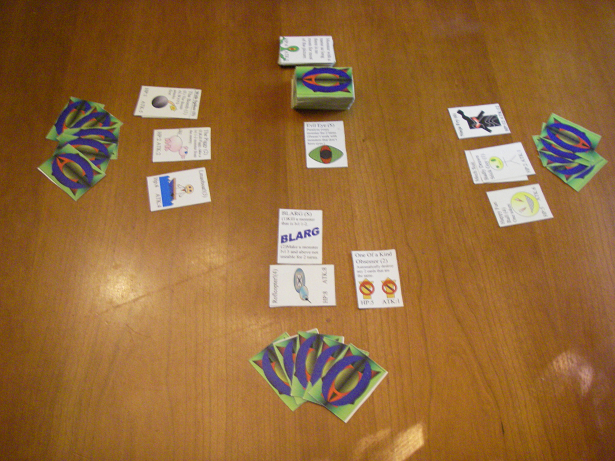
Final Verdict: A great success - with some careful balancing, and a bit of luck, this turned out to be a great game we could play again and again.
Color Squares
An interesting game that utilizes 1"x1" foam tiles. Players attack each other with spells constructed from blueprints each player picks at the beginning of the game. Life points and mana are kept track of using squares. As players sometimes pick mana randomly from the bin, certain colors can become unlikely, if not impossible, to pick. The different colored spell books that contain the blueprints players use for their spells have unique effects and configurations for spells, giving each spell book a different feel. This game is also the first one I made with a rulebook to provide players with clear rules and restrictions.
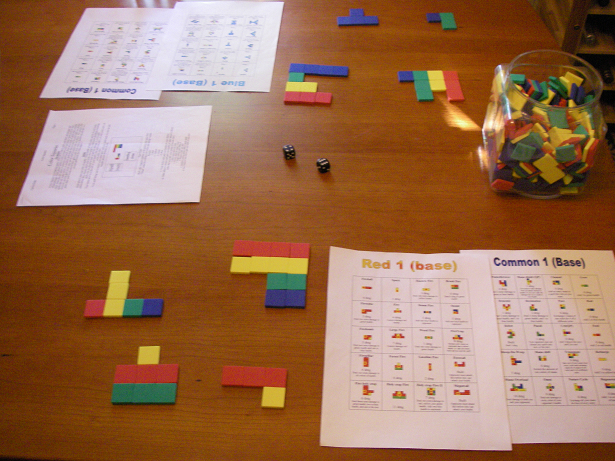
Final Verdict: A truly fun game - with the different spell books providing vastly different feels and enough other options (such as taking two spell books) to keep players from running out of possibilities, there's always another combination to try and a new strategy to learn.
Necronomic Solitaire
A quick solitaire game I designed specifically for a tarot card deck, this takes an interesting spin on standard solitaire. The player is confronted with a horde of Lovecraftian beasts (represented by the major arcana), each of which has its own strength. The player must then make straights (as in standard solitaire) which are their "spells" in order to fend off the evils. If they fail and can't make any more spells, everything in front of them gets permanently discarded. If their deck is entirely discarded in this way, they lose. Luck and strategy combine to make a great game.
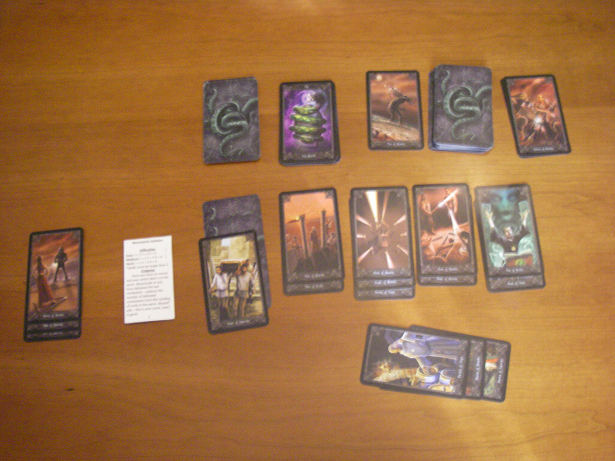
Final Verdict: With interesting gameplay that encourages quality over quantity in spells, taking risks, and more strategy than in standard solitaire - this is a game I come back to again and again whenever I have time to kill.
Tarot Kingdoms:
My second game using tarot cards, this has all the players working cooperatively against luck and time, rather than competing with each other. Players work to complete quests in order to raise a force big enough to counter the oncoming armies of the opposing kingdoms. As the game progresses, players are prompted to draw "kingdom cards," which are special cards that cause bad effects to happen (taking cards off of quests and potentially destroying them so they can never be completed). Players must complete three of the four quests (represented by the four suits) to win. I also made a card-sized rulebook that could be slipped into the bag the cards are carried in for easy transportation.
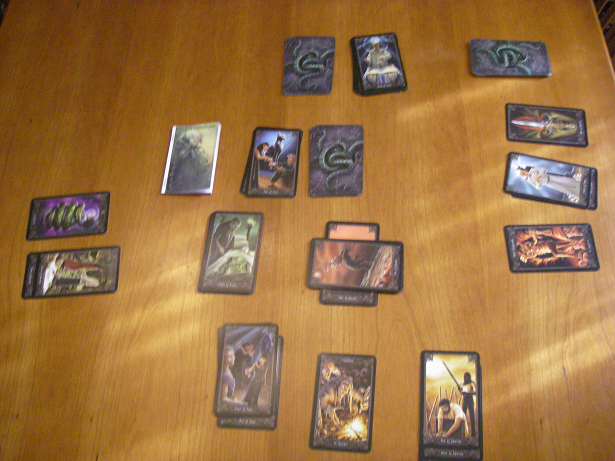
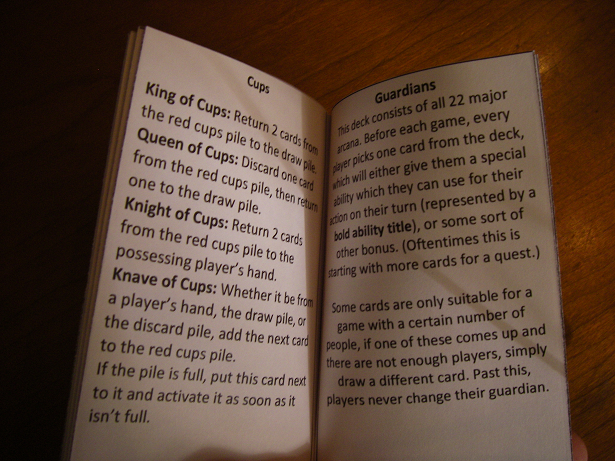
Final Verdict: The cooperative gameplay is fun, and the multitude of situations that can come up with the unique powers each player picks at the beginning of the game, as well as the different order cards can be drawn in, all combine to create a unique experience every time, for any number of players (1-26 potentially).
Dominion: StarCraft:
Borrowing ideas from the card game Dominion and the ever-popular video game StarCraft, I've created a StarCraft-themed card game that has enough StarCraft in it to please all the fans I've played it with so far, and enough of my own style to make it a unique and fun game. Each player picks one of three races, and then dukes it out with the others, buying units and buildings to try to get the strongest army. Their "store" is the large clump of cards in the middle, which holds everything they can buy. Anticipating an opponent's moves and strategy is key to coming up with a suitable counter, and the different races, units, and combinations that can be used make this a game that's for all those with a mind for outsmarting their opponent.
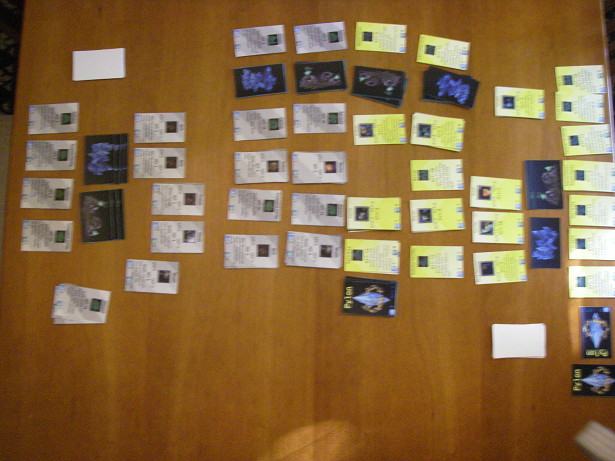

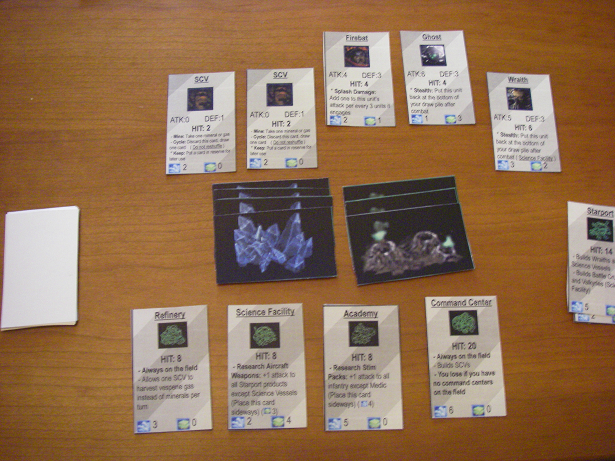
A small presentation I've made to show the basic gameplay of Dominion: StarCraft -
Final Verdict: Absolutely fantastic, the best game I've made yet. The different units, races, and strategies make it unique, and multiple rounds of prototyping and balancing have made everything balance out well - nothing is overpowered or unbeatable, but some strategies definitely beat others. Having literally played this every day for over five weeks and still not gotten tired of it or run out of new combinations to try, this is absolutely my pride and joy of game creation.
Failures:
You may be wondering, "Is it possible that he created all these great games without ever making a mistake big enough to mess up an entire game?" Well, any game designer worth his salt knows the answer to that, and it's "No." So here are a couple of my more memorable failures that have taught me how to do it better next time.
Missile Wars:
A game where players constructed missiles with different detonation patterns in an attempt to kill each other's cities; this was played on a board made up of 1"x1" squares.
Failure Points: The boards were too cramped, making it far too simple to just shoot down each other's missiles. This, combined with what ended up being clunky gameplay (moving was sluggish, building was slow, etc.), made for a boring game that ended in far too many stalemates to be fun.
Lesson Learned: A game where there's no way to defend yourself can be annoying, but a game where it's so easy to defend yourself you have to TRY to lose is absolutely wretched.
THG - The Hacking Game:
A game where players hacked into and took over a series of servers, with an arsenal of programs at their disposal that they prepared and then released in order to break and enter, this was art-heavy with a ton of options for programs and different strategies that arose from them.
Failure Points: I never finished it - mostly because I had only a little idea about how the gameplay was going to work before I started making the art. I finished all the icons for the different programs, all the boards, and the different program suites, and then sat there and realized that I had no idea how a large chunk of programs would work, how combat when both players were in one server would work, or really how pretty much anything would end up working. My biggest "learn from your failures" moment so far.
Lesson Learned: I've taken to prototyping absolutely everything to make sure the gameplay is fun before I start making the art for it or adding in more and more content.